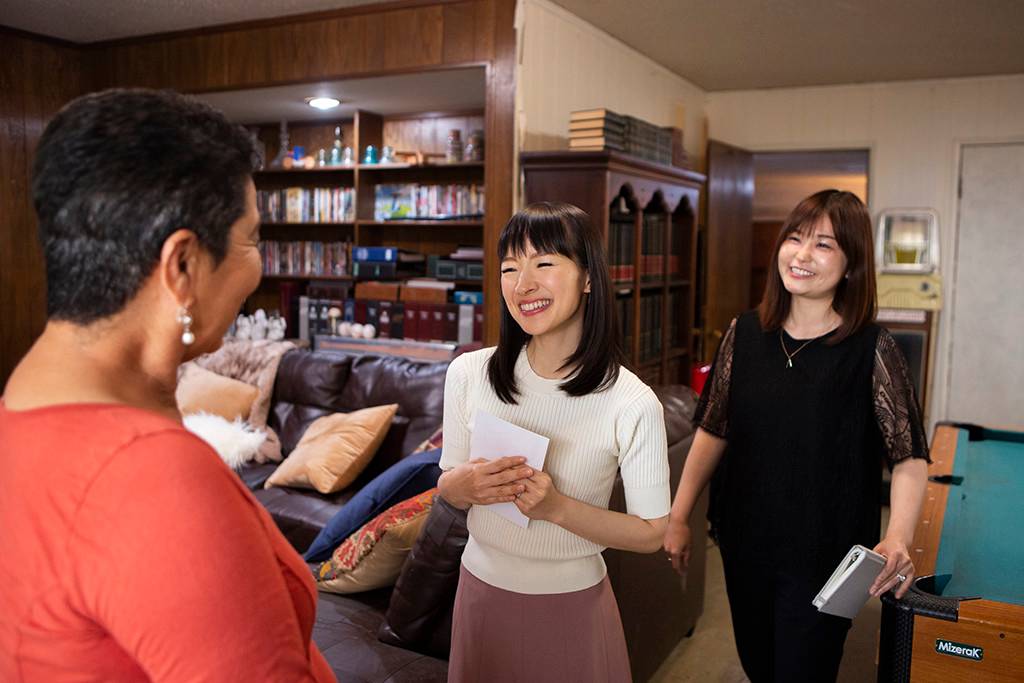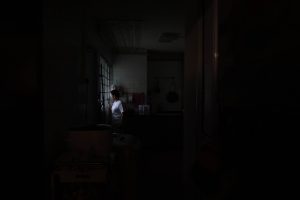If you’re looking to Marie Kondo your life in tumultous 2021, I suggest you do so without watching her show. Whatever merits the KonMari method may possess, it does not make for good entertainment.
As television, Tidying Up with Marie Kondo is infernally dull.
Netflix calls it a “series” but the show is really just one episode copy-pasted eight times. Sometimes it’s a gay couple and sometimes they swap the middle-class white family for a middle-class Black/Asian family, but you will be hard-pressed to tell the difference. Everyone sounds so goddamned upbeat and cheerful, they sort of blend into one person.
Here’s what you can expect: World-renowned organising consultant Marie Kondo will exit a black MPV dressed in her signature beige cardigan, knee-length skirt, and black tights. She has a translator named Lida, to whom she ventures remarks about how “cute” the house looks, or how much “positive energy” she can feel from the place of habitation.
The owner/victim opens the door and Marie greets them with a high-pitch, opera-length squeal of, “Hiiiiiiiiiiiiiiiiiiiiiiiiiiiiiiiiiiiiiiiiiiiii.” This high-pitch squeal/gasp/chirp is, in fact, Ms Kondo’s primary mode of communication. As they embark on a tour of the house, Ms Kondo will “Ahhhhhhh”, “Ohhhhhhh” and “Eeeeeee” at every room and every laundry basket, like my seven-year-old niece when I present her with a new stuffed animal.
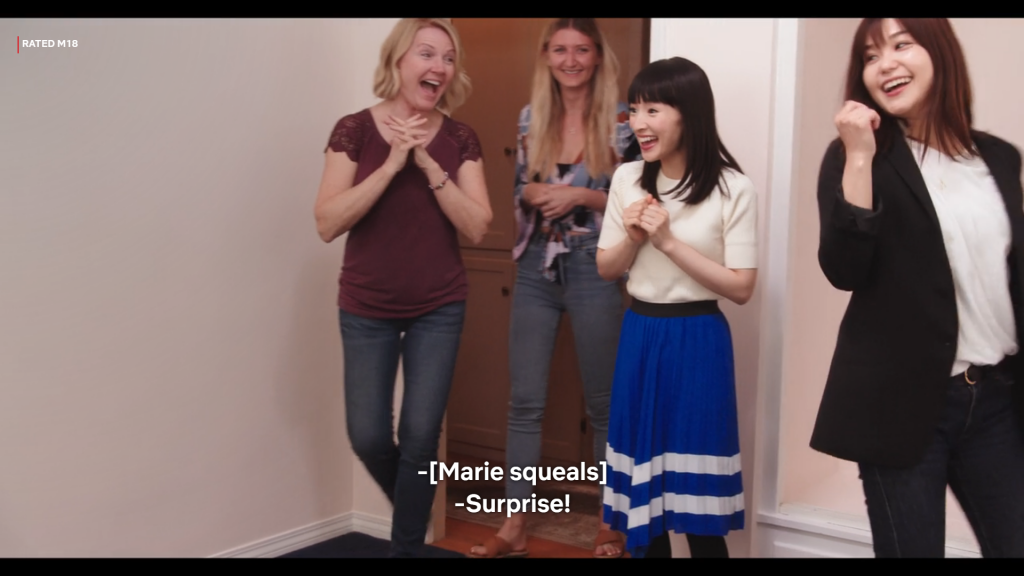
From there, it’s all about the KonMari method. The victim gathers all of their clothing in one massive heap and holds each piece in hand, asking themselves if this sock or shirt “sparks joy”. If yes, it is folded the KonMari way (in thirds, stored upright). If not, they thank the shirt for its service before throwing it out. Once the clothes are sorted, they move on to books, kitchen utensils, make-up, garage riff-raff, until voila! Their life is magically transformed!
You know their life has been magically transformed because the people will turn to the camera and tell you so. They will say things like, “My life has totally changed,” or, “Our relationship is in a different place now.”
It’s all very positive and life-affirming and so on, but that, I think, is also the problem.
Good drama requires some form of struggle. Marie Kondo, however, is so free of darkness—whether in the form of betrayal, disappointment, anger, failure, or even skepticism—that the whole enterprise feels unreal; almost glib. We don’t get a visceral sense of either frustration or despair, and therefore, no sense of satisfaction when their lives are said to ‘begin anew’. The so-called life-changing magic feels inexplicable and unconvincing, like a store-bought parlour trick for Muggles.
Deeper problems—like grief or the gendered attitudes towards housework—occasionally bubble to the surface, but they are glossed over. Douglas, the musician-husband (ep. 3) never truly confronts why he shirks housework, and Wendy Akiyama (ep.2)’s compulsive shopping is never spoken of at all. Once the house is in order, the underlying problems peeking out from the under the mess are either quickly forgotten or deliberately ignored.
The end result is not a convincing story of overcoming one’s demons, but a bland diary of superficial progress; featuring one happy loving couple turning into a happier, even more loving couple thanks to streamlined underwear storage.
Perfectly good ASMR if you’re suffering from insomnia, but piss-poor entertainment for the bored and lonely. If you need something that’s equally positive but actually watchable, I suggest torrenting The Great British Bake-off instead.
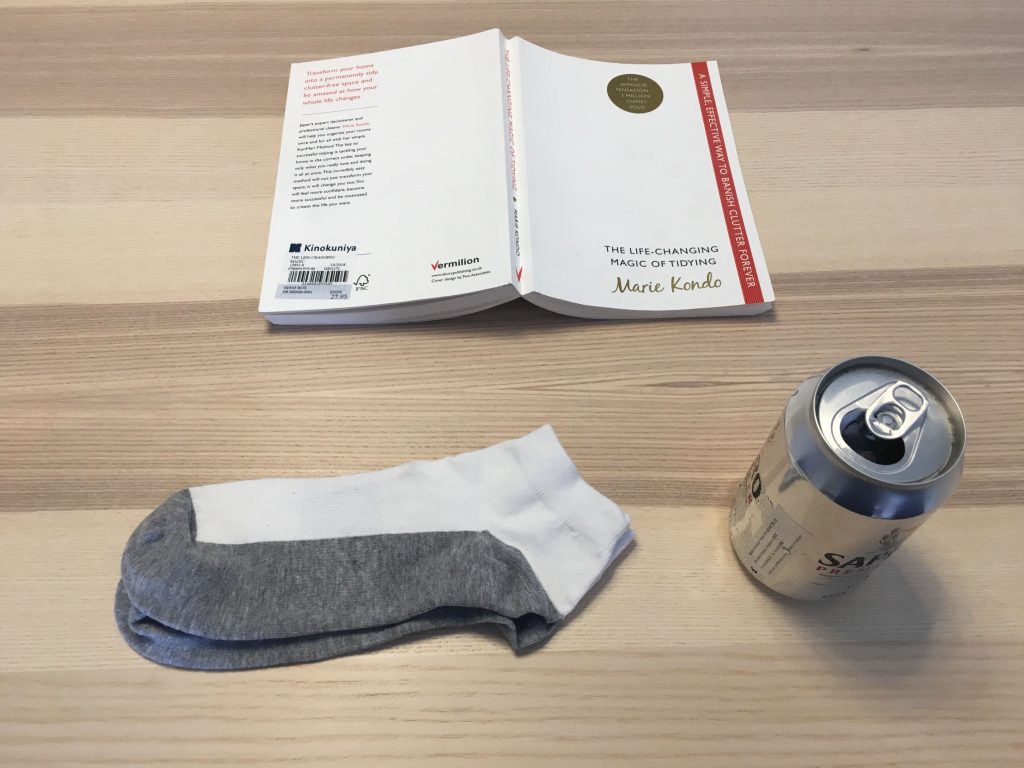
But we may be getting ahead of ourselves, because like a cooking show, Tidying Up is as much a step-by-step guide as it is popcorn fodder. If KonMari can deliver one-tenth of the existential life-changing magic that it promises, then all of the show’s tedium will be forgiven.
So I went to Kinokuniya, bought the book, and gave it a shot.
After one afternoon of Kondo-ing my condo, this Konvict is happy to report that,
1. Marie Kondo doesn’t work for him, but,
2. He has a better understanding of why Kondo has attracted more Konverts than Kong Hee.
The reason is simple. Tidying Up with Marie Kondo is not about tidying up at all; it’s just mindfulness with a dash of Martha Stewart.
As a method for organising your house, KonMari is borderline dysfunctional. It only works if you’re a certain type of person for whom household objects are more about fetish than function; that is, if you’re already invested in the whole Technicolor consumerist daydream.
Try as I might, this cynic found it impossible to summon any feelings of joy as I beheld saggy boxers, misshapen socks, and grey T-shirts from Uniqlo. They did not spark any joy when I first purchased them because of price and necessity, and it seems absurd to demand joy from them one year later, when the elastic has all but worn out.
Yet, I can’t just throw everything out and go about butt-naked, because even Yishun-dwelling Neanderthals like me understand the concept of pants. Some articles of clothing must be kept and that’s where you encounter problem number two: Kondo’s much-vaunted folding method.
Marie Kondo recommends folding your clothes in thirds so it can stand upright like a hardback novel, but this technique only works if all of your clothes are high-quality and 100% cotton. If you own a lot of threadbare rags or polyester gym clothes, prepare to get fucked. Those lovely fabric rectangles will collapse like Jenga 9/11s the moment you let go. You have to build a, erm, wall just to keep them vertical. It seems much easier and more sensible to just fold them and stack them like you see in the store.
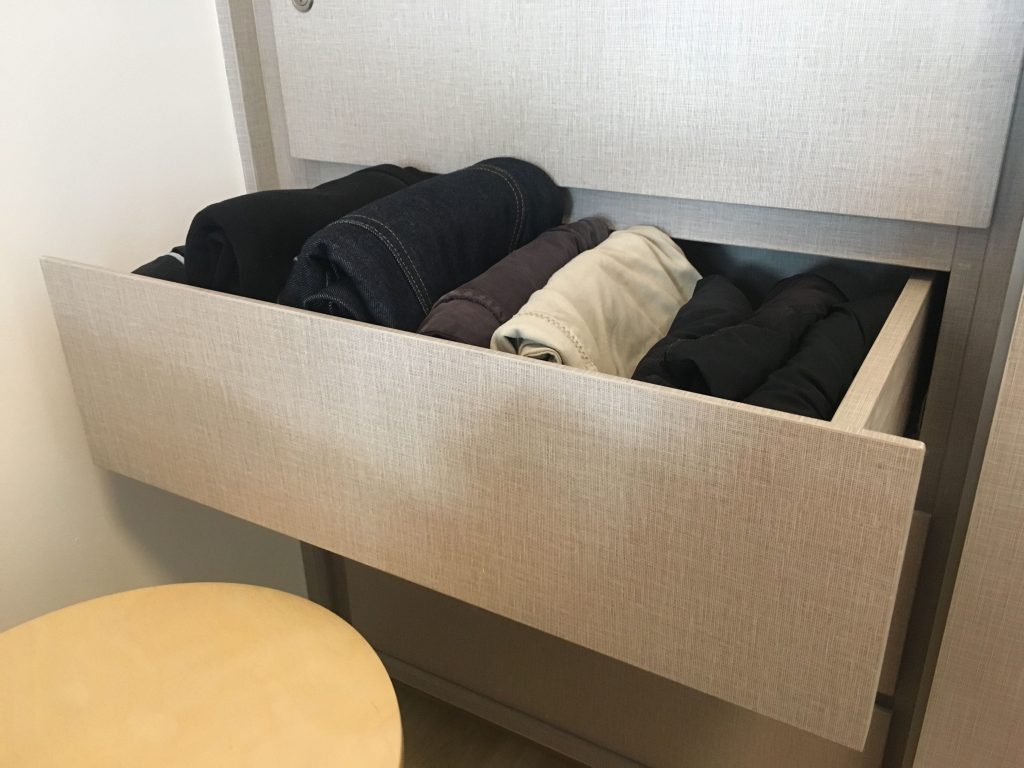
Ms Kondo says ‘No’ to stacking because “stacking weakens and exhausts the things that bear the weight of the pile, just imagine how you would feel if forced to carry a heavy load for hours.” Saywhut. I sympathise but can’t do anything because otherwise, I would not be able to close my drawers.
So after two hours of trying to establish an emotional connection to my trousers and refolding them into thirds, I was forced to unfold them, then refold them in the old way.
Spark joy, it did not.
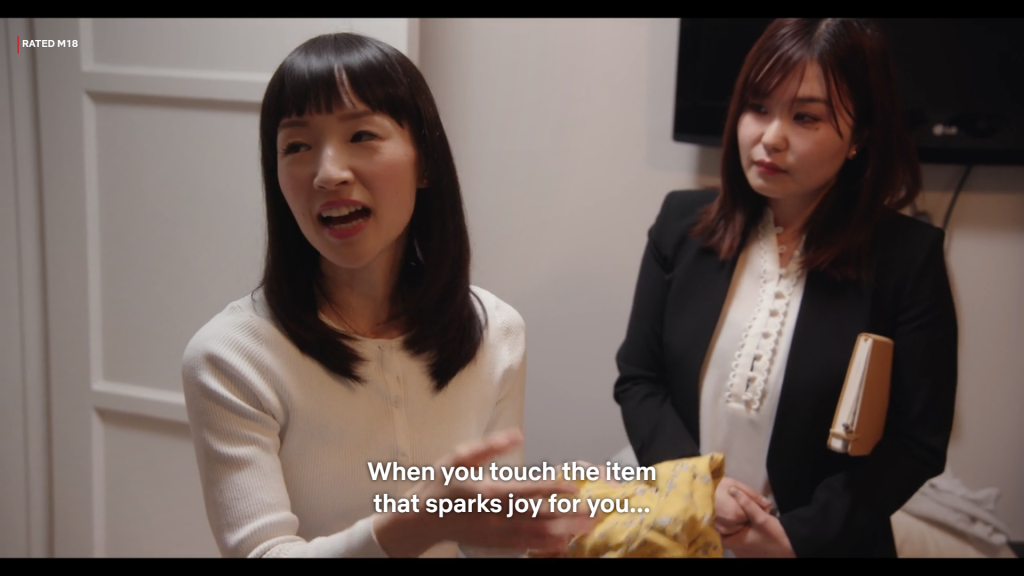
Up until the point my drawer jammed, I did feel some semblance of serenity after following Ms Kondo’s edicts. Silly as it sounds, there was a palpable sense of zen when I knelt on the floor to smooth out the wrinkles in my shirt, trying as I did so to “convey love through my palms” like some kind of laundry Shaman. Although no ‘joy’ was detected, I did experience a sense of wellbeing not unlike what I feel when watering my houseplant(s) or helping my mom to dice onions.
I think this is the real reason why the KonMari method is so popular. It’s not about tidying up, but waking up.
Reducing clutter is the end goal, but the actual process is all about building a heightened sense of awareness towards one’s life by way of whispering encouragement to your sneakers and handbags. In short, KonMari is just another variation of the mindfulness that’s being preached by everyone in general and self-care gurus in particular.
This is why Marie Kondo encourages you to do kooky shit like consider the welfare of your socks (don’t ball them!) and to clutch each item of clothing to your bosom (Spark joy! J-O-Y). Most objects do not have any meaning except what we ascribe to them. By asking you to meditate on that H&M sweater, Marie Kondo is really just asking you to meditate upon your life, to stop and consider the moments/memories associated with the object, and therefore to examine one’s past and present.
But whereas normal, free-form meditation is vast and daunting, Ms Kondo’s brand of mindfulness is structured, grounded, and oh so accessible. The mindful contemplation is broken down to categories (clothes, books, miscellaneous) and then broken down further into individual pieces of clothing (socks, shoes, scarfs), so that we of the short attention spans and low commitment issues can experience mindful living, in twitter-sized portions.
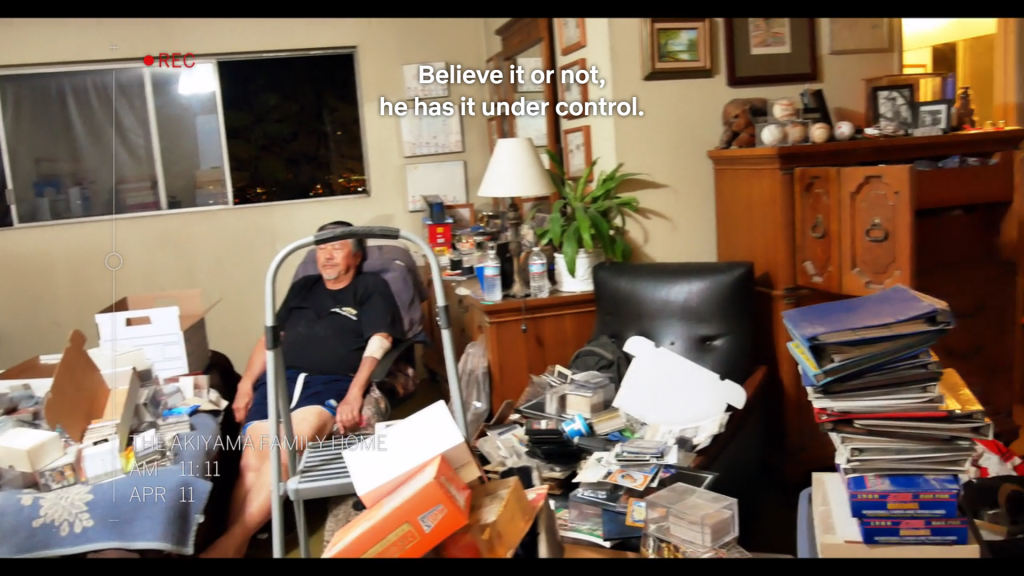
Why this should prove so popular should come as no surprise to anyone. Today, we live in a state of constant distraction thanks to smartphones and social media. Life happens, but it seems less like a journey and more like a game of whack-a-mole, where we are stirred into action by an endless barrage of emails, Slack notifications, deadlines, WhatsApp inquiries, half-forgotten appointments, and other shit screaming for attention. As we whack these proverbial moles day and night, our sense of reality and purpose slowly slips away, until we are reduced to autopilot.
At the same time, there are always new things to buy, new events to attend, and new skills we must acquire to stay relevant, yet so little time to pursue any of these desires to fruition. The end result is a sense of muted chaos, of things threatening to spiral out of control, and much anxiety as a consequence.
Marie Kondo is an attempt to impose order upon this chaos, one joyous sock at a time. It is marketed as a solution to clutter, but it’s really an antidote to modernity in the same vein as Minimalism or Deep Work. If we can be mindful, conscientious, and selective about our domestic inventory, then perhaps the rest of our lives would fall into order.
Personally, I don’t buy this remedy because people are not merely the sum of what they own, and because any remedy that purports to fix the entirety of Life/The World—i.e. Barack Obama or KONY 2012—will inevitably fail. The problem is too complex, even for the most manic of organisers.
Nevertheless, it is probably worthwhile to KonMari your cupboard even if it does not change your life, because the aims of KonMari are noble, even if her promise of ‘forever’ is outsized and hyperbolic.
There is virtue in the method, but it’s not in the impractical folding technique or the vague spirituality of saying “hello there” to your slippers. The virtue comes from trying to be awake and mindful and appreciative.
Even if tidying cannot fix your life and it will be soon be a mess again, you’ve tried. Better to try and try again than to give in and become a zombie, staring into the black mirror of your phone.
Just don’t watch the show. Life’s too short for boring TV.

